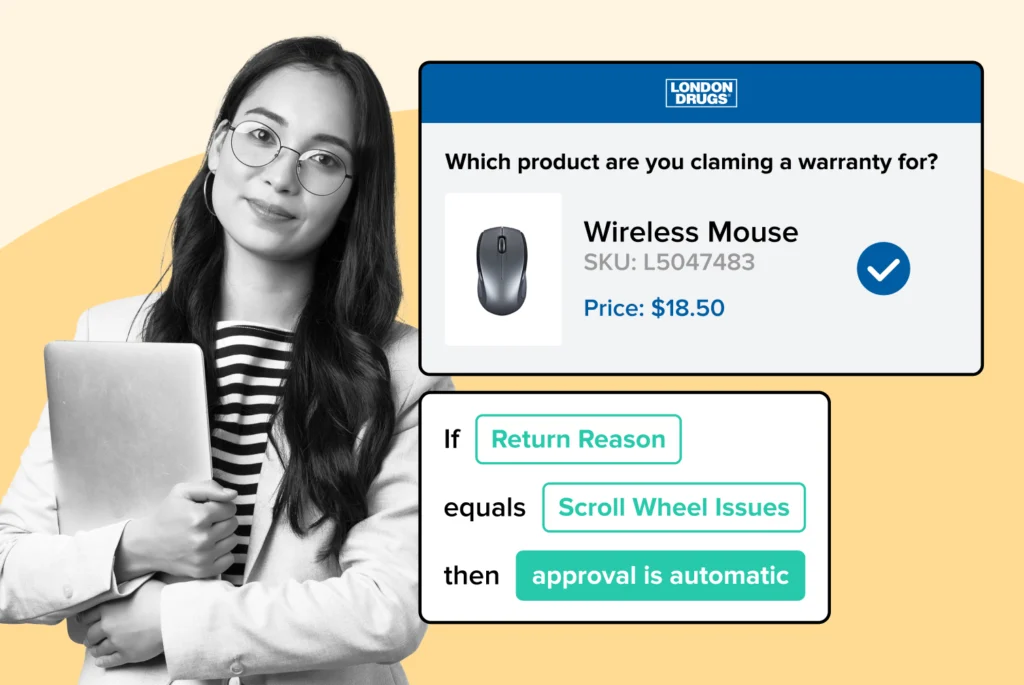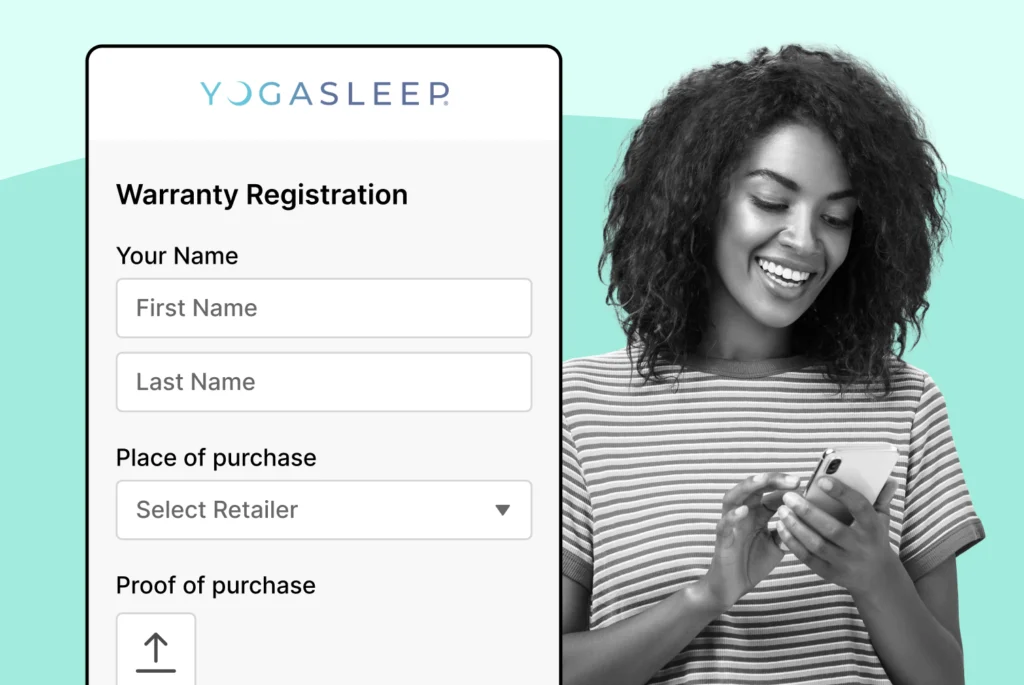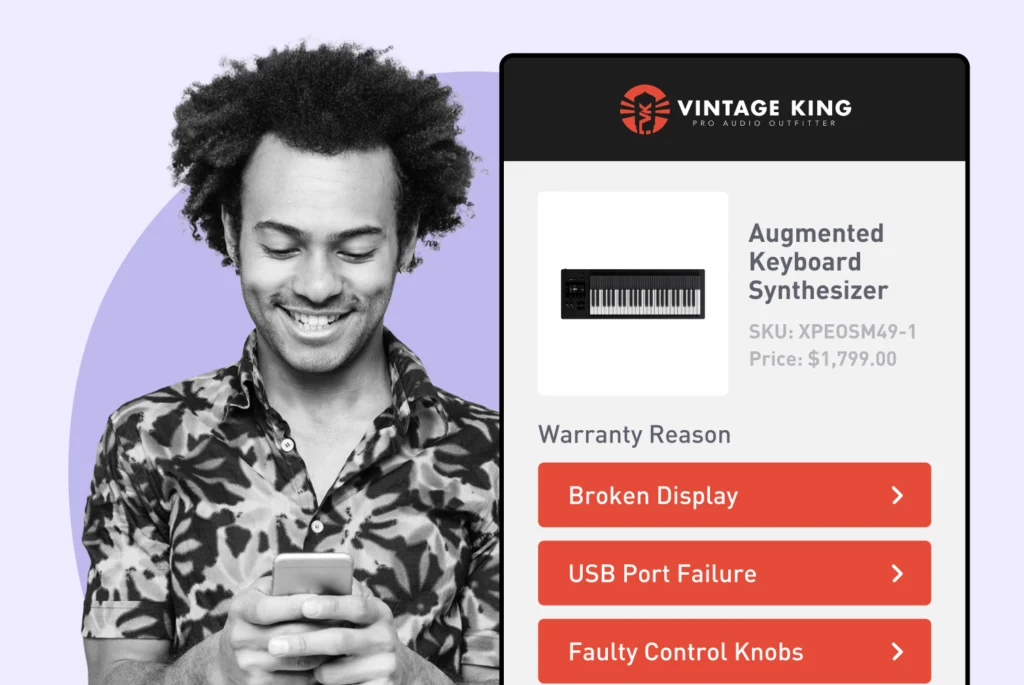
Shipment Exception Handling and Customer Communication Tips
Learn effective strategies for handling shipment exceptions and improving customer communication. Read the article for practical tips and insights.
Shipping, Tracking & Notifications
Boost customer experience and reduce support tickets
Realtime order and shipment tracking
Proactive order and shipping notifications
AI-Enhanced Discounted Labels
Predictive pre-purchase estimated delivery dates
Self-Serivce branded order tracking
Effortless experience delivered
Identify and Resolve Order Issues
Realtime order and shipment tracking
Make returns profitable and delight customers
Flexibility to define any return destinations & conditions
Simplify returns for your customers and team
Incentivize exchanges over returns
Returns management made easy for your team
Returns management made easy for your team
Easy claims and smart upsells
Understand why your customers are returning
In-Store & Curbside Pickup
Unify the online and the in-store experience
Hassle-free pickup experience for customers
In-Store dashboard to keep operations streamlined
In-Store and Online orders unified
Drive foot-traffic to your stores
Shipping, Tracking & Notifications
Boost customer experience and reduce support tickets
Realtime order and shipment tracking
Proactive order and shipping notifications
AI-Enhanced Discounted Labels
Predictive pre-purchase estimated delivery dates
Self-Serivce branded order tracking
Effortless experience delivered
Identify and Resolve Order Issues
Realtime order and shipment tracking
Make returns profitable and delight customers
Flexibility to define any return destinations & conditions
Simplify returns for your customers and team
Incentivize exchanges over returns
Returns management made easy for your team
Returns management made easy for your team
Understand why your customers are returning
In-Store & Curbside Pickup
Unify the online and the in-store experience
Hassle-free pickup experience for customers
In-Store Dashboard to keep operations streamlined
In-Store and Online orders unified
Drive foot-traffic to your stores
Boost customer experience and reduce support tickets
Realtime order and shipment tracking
Proactive order and shipping notifications
AI-Enhanced Discounted Labels
Predictive pre-purchase estimated delivery dates
Self-Serivce branded order tracking
Effortless experience delivered
Make returns profitable and delight customers
Flexibility to define any return destinations & conditions
Simplify returns for your customers and team
Incentivize exchanges over returns
Returns management made easy for your team
Equip your team for precise return checks.
Easy claims and smart upsells
Understand why your customers are returning
Unify the online and the in-store experience
Hassle-free pickup experience for customers
In-Store Dashboard to keep operations streamlined
In-Store and Online orders unified
Drive foot-traffic to your stores
Find the answer to all your questions
Take a step by step trip through our functionality to see how we can improve your ecommerce processes.
Explore the most comon questions about WeSupply
Calculate the ROI that WeSupply can bring you
Read actionable articles on how to optimize your post-purchase experience and decrease support tickets
Get inspired by stories of how our customers implemented an effortless post-purchase experience
Wondering if WeSupply is a good fit for you? Read through our use cases to see how we can help you increase conversion & improve CX!
A Deep Dive into Top Companies' Order Tracking & Returns Strategy
Find the answer to all your questions
Explore the most comon questions about WeSupply
Calculate the ROI that WeSupply can bring you
Request a no strings attached review of your current shopping experience and missed conversion opportunities
Take a step by step trip through our functionality to see how we can improve your ecommerce processes.
Read actionable articles on how to optimize your post-purchase experience and decrease support tickets
Get inspired by stories of how our customers implemented an effortless post-purchase experience
A Deep Dive into Top Companies' Order Tracking & Returns Strategy
Wondering if WeSupply is a good fit for you? Read through our use cases to see how we can help you increase conversion & improve CX!
In today’s fast-moving world of ecommerce, customer expectations are sky-high. Shoppers expect fast delivery, transparent communication, and a seamless post-purchase experience. But as businesses grow, so does the complexity of order fulfillment. One of the most common fulfillment challenges is managing split shipments—when a customer’s order is divided into multiple packages due to inventory locations, backorders, or product size. This process is also known as a partial shipment, where only part of the customer’s order is shipped at a time. While this strategy can boost efficiency and speed, it often creates a fragmented tracking experience that frustrates customers.
That’s where unified tracking comes in. A unified tracking view brings clarity to the chaos. It allows customers to track every item in their order—no matter how many shipments or carriers are involved—in one easy-to-navigate interface. This article dives into how ecommerce businesses can simplify multi-shipment orders using unified tracking, reduce support tickets, and deliver a top-notch customer experience.
Split shipments occur when items from a single order are shipped separately. This might happen because items are stored in different warehouses, some products are backordered items, or the order includes oversized goods that must be shipped individually. Split shipments may involve two or more packages, and it’s an increasingly common approach in modern logistics because it offers flexibility and speed.
However, for customers, it can be confusing. They may receive one item while still waiting for others, unsure whether their order is complete or partially delivered. Customers may receive multiple deliveries when their order is split. Without a clear, unified way to view shipment progress, customers may turn to your support team with questions—clogging up communication channels and reducing satisfaction.
When implemented correctly, split shipments—also known as partial shipments—can benefit both the business and the customer. Customers receive parts of their orders faster, rather than waiting for everything to be available. This keeps them engaged and satisfied, especially if they urgently need certain items.
From an operations perspective, split shipments allow companies to fulfill orders from the most efficient warehouse, lowering shipping costs and reducing delivery times. This approach can lead to significant savings by optimizing transportation and shipping expenses. It also enables businesses to process partial orders instead of delaying fulfillment due to a single out-of-stock item. Efficient management of split or partial shipments, through strategic planning and advanced tracking, can further improve outcomes by streamlining logistics and elevating the customer experience.
Despite their benefits, split shipments introduce complexity. Customers may receive multiple tracking numbers from different carriers. Often, these are shared separately or inconsistently, requiring the customer to visit multiple carrier websites to get tracking information and updates.
This fragmented experience leads to increased customer service inquiries, as customers may believe part of their order is lost or delayed. These issues can negatively impact customer satisfaction. From the business side, managing multiple tracking sources without standardization can result in inefficiencies, missed updates, and operational blind spots. Relying on manual updates can further exacerbate these issues.
Unified tracking offers a powerful solution. Rather than directing customers to individual carrier websites or sending multiple tracking links, businesses can use a centralized platform that consolidates all tracking updates into one branded page, providing real time updates.
This not only enhances visibility for the customer but also builds trust. When customers see that your brand is keeping them informed with timely, consolidated updates, it reassures them that their order is being handled professionally.
Internally, unified tracking helps your team monitor delivery performance across all carriers, spot delays early, and provide proactive communication. This unified approach enables better coordination among teams, ensuring everyone is aligned and can respond quickly to any issues. It turns fragmented post-purchase journeys into a smooth, branded experience.
Platforms like ShipStation offer robust support for multi-package shipments. You can assign a master tracking number for the overall order and individual tracking numbers for each package. This setup ensures that both businesses and customers can monitor all packages within the same order easily. In many cases, especially with large or heavy orders, items may be shipped in multiple boxes rather than a single package. This approach is necessary when a single package isn’t feasible due to size or weight constraints.
However, many systems only share the master number by default. Businesses must make sure that customers also receive child tracking numbers—especially when shipments arrive at different times. Sending these via email or integrating them into a unified tracking page solves this issue and prevents confusion.
Carriers have their own rules too. For instance, UPS allows up to 20 packages in a multi-package shipment, FedEx supports up to 100, and DHL Express supports up to 999. Understanding these limitations is critical for planning and configuring your shipments correctly.
For ecommerce businesses using platforms like Shopify, Magento, WooCommerce, or BigCommerce, unified tracking apps can bridge the gap. For example, the Shopify app “Unified Tracking” enables customers to track their orders by entering their order ID or email. Merchants can connect multiple courier accounts, and the app will pull tracking updates from all of them. These tools significantly improve the tracking experience for online orders, making it easier for both customers and merchants to monitor order status and manage fulfillment.
By integrating this functionality directly into your website, you create a consistent, branded post-purchase experience. Instead of customers bouncing between sites, they remain within your ecosystem—increasing trust and engagement.
Unified tracking platforms often come with real-time update capabilities through APIs or webhooks. These technologies push updates to customers as soon as they happen, triggering SMS or email alerts when packages ship, are out for delivery, or are delayed.
Proactive communication reduces customer anxiety and shows that your brand is in control. Instead of waiting for customers to reach out about a problem, your system can notify them first, enhancing transparency and improving satisfaction.
Effective inventory management plays a big role in successful split shipments. Businesses need real-time visibility into product availability across warehouses and distribution centers, as well as accurate demand forecasting to decide which items to ship first.
By implementing an order management system (OMS) or warehouse management system (WMS), businesses can optimize fulfillment, reduce unnecessary splits, and ensure timely shipments. Managing backorders and syncing inventory updates prevents delays and improves the entire order lifecycle.
Clear communication starts at the point of purchase. Let customers know that their order may arrive in multiple packages, especially if it contains backordered, oversized, or heavy items. Orders with such products may be split into multiple shipments, which can affect delivery times and logistics.
Provide a single tracking page that displays all packages within an order, complete with their estimated delivery dates and current statuses. When customers know what to expect, they are more likely to be satisfied—even if packages arrive separately.
To maximize the effectiveness of your unified tracking system:
Centralize all tracking data from carriers and warehouses into one platform.
Standardize status updates so customers can easily interpret what “In Transit” or “Out for Delivery” means.
Support global shipping by integrating international carrier data.
Establish clear processes for splitting orders and ensure split shipments are tracked efficiently within your system.
Offer self-service options like delivery preferences or rescheduling.
Include support access on the tracking page in case customers need help.
These best practices not only improve usability but also increase operational efficiency and reduce support volume.
Split shipments require thoughtful shipping logistics. Consider the transportation costs and overall cost implications of shipping separately versus waiting for a complete order. Often, it’s more cost-effective and customer-friendly to send items in stages, especially if using regional carriers or 3PL partners.
Use smart shipping labels and logistics software to ensure each package is properly tracked and labeled. This avoids errors, reduces delays, and keeps your tracking system accurate.
In today’s ecommerce landscape, customers shop across a variety of channels—your website, marketplaces, social media, and even physical retail locations. Managing fulfillment and tracking for orders coming from different channels can be challenging, but it’s essential for delivering a consistent and satisfying customer experience.
By unifying tracking across all sales platforms, businesses can streamline operations and ensure that customers receive accurate, up-to-date shipping information no matter where they made their purchase. This approach reduces the risk of errors, such as missed shipments or incorrect tracking links, and helps fulfillment teams manage inventory more efficiently across multiple locations.
Effective inventory management is at the heart of successful multi-channel fulfillment. With real-time visibility into inventory levels, businesses can fulfill orders promptly, avoid stockouts, and allocate products from the most optimal warehouse or retail location. This not only speeds up the delivery process but also increases customer satisfaction by meeting or exceeding delivery expectations.
Additionally, leveraging data analytics from unified tracking systems gives businesses a better understanding of customer preferences and buying patterns across different channels. This insight enables smarter decisions about shipping methods, logistics providers, and inventory allocation—ultimately driving a more efficient and customer-centric operation.
Unified tracking transforms post-purchase interactions. It provides clarity, eliminates confusion, and reassures customers that their order is progressing as expected.
Customers feel empowered when they can view all their deliveries and shipments in one place, check delivery timelines, and receive proactive updates. It builds trust, reduces support inquiries, and keeps them engaged with your brand throughout the fulfillment process.
From a business standpoint, unified tracking leads to fewer service tickets, lower fulfillment costs, and improved visibility across the supply chain. By standardizing tracking data, you gain actionable insights on carrier performance, delivery speed, and recurring issues.
These insights can guide decision-making, such as which carrier to prioritize or where to optimize warehouse operations. Managing both single shipment and split shipment orders within a unified tracking system ensures that each order, regardless of how it is fulfilled, is tracked efficiently and communicated clearly to customers. In the long term, unified tracking supports scalable growth and customer retention.
Implementing unified tracking is just the first step—measuring its impact is crucial for ongoing improvement. By establishing clear key performance indicators (KPIs) and leveraging analytics, businesses can gain valuable insights into their logistics operations and customer satisfaction.
Some of the most important KPIs for unified tracking include order fulfillment rates, average shipping times, and customer satisfaction scores. Monitoring these metrics helps businesses identify bottlenecks in the delivery process, optimize shipping strategies, and ensure that customers receive their orders on time.
Real-time data from unified tracking platforms also plays a vital role in inventory management. By analyzing trends in inventory levels and order patterns, businesses can improve demand forecasting, reduce the risk of stockouts, and make more informed decisions about restocking and warehouse allocation. This leads to more efficient order fulfillment and better supply chain management, which in turn supports higher profit margins.
Furthermore, tracking analytics can reveal which logistics providers are performing best, where shipping delays are most common, and how different shipping methods impact customer satisfaction. Armed with this information, businesses can refine their operations, negotiate better rates, and deliver a superior customer experience.
The world of unified tracking is rapidly evolving, with new technologies poised to transform how businesses manage and monitor shipments. One of the most exciting trends is the integration of artificial intelligence (AI) and machine learning (ML) into logistics operations. These technologies can analyze vast amounts of shipping data to predict delays, optimize delivery routes, and provide customers with more accurate real time tracking updates.
Another major innovation is the growing use of Internet of Things (IoT) devices. By equipping shipments with smart sensors, businesses can monitor the location and condition of packages in real time, providing customers with unprecedented visibility and peace of mind throughout the delivery process.
Blockchain technology is also making waves in logistics, offering secure and transparent tracking of shipments from origin to destination. This not only increases trust but also helps reduce errors and fraud in the supply chain.
As customer expectations continue to rise, businesses that invest in these cutting-edge technologies will be better positioned to increase customer satisfaction, reduce shipping costs, and deliver a seamless customer experience. Staying ahead of these trends ensures that your operations remain efficient, your customers stay informed, and your business maintains a competitive edge in the ever-changing world of ecommerce logistics.
Keep your customers engaged during the delivery experience
Book a quick call with our experts to see how WeSupply can help you engage your customers with relevant updates through the right channel, at the right time.
Split shipments are often necessary in ecommerce, but they can quickly become a source of confusion and frustration for customers—especially when tracking multiple packages across different carriers. That’s where WeSupply comes in. We help ecommerce brands turn fragmented tracking into a seamless, unified experience that keeps customers informed and satisfied at every step.
With WeSupply, customers no longer have to dig through emails or track packages one by one. Our Unified Tracking View brings everything together—from the moment the order is placed to the final delivery—making post-purchase communication simple, transparent, and stress-free.
Here’s how WeSupply makes unified tracking for multi-shipment orders easy and effective:
✅ Branded Tracking Page: Present a clear, professional, and unified view for customers to track all packages in one place.
✅ Real-Time Journey Dashboard: Give your internal teams full visibility into every shipment’s status, across 1000+ carriers, from dispatch to delivery.
✅ Proactive Notifications: Automatically send real-time updates for each shipment to keep customers in the loop—no more WISMO tickets.
✅ Customizable Workflows: Tailor communication and tracking logic for split orders, so you can clearly show what’s been shipped, what’s pending, and what’s on the way.
✅ Lost, Delayed, or Undeliverable Package Management: Instantly detect issues with any shipment and resolve them before they impact the customer experience.
WeSupply helps you take control of the entire delivery journey—even when it’s complex—by merging multiple shipment updates into one easy-to-follow tracking experience. The result? Fewer support tickets, fewer complaints, and happier, more loyal customers.
Start transforming how you manage split shipments today. Schedule a demo and see how WeSupply’s unified tracking can simplify your operations and boost customer satisfaction.
Combat inconvenience with proactivity & self service
Book a quick call with our experts to see how WeSupply can help you make returns easy for your customers with a beautiful, self-service solution that makes their experience easier while also providing new ways to lower costs and earn back revenue.
Split shipments are a reality of modern ecommerce—but they don’t have to create confusion or drive up support tickets.
With WeSupply, you can simplify the entire post-purchase experience by offering customers a unified tracking view that consolidates updates from all dropshippers and carriers, no matter how many boxes their order arrives in. The branded tracking page gives shoppers a clear picture of what’s arriving and when, while real-time updates, automated notifications, and proactive delay management keep expectations aligned and frustration low. Internally, your team benefits from a centralized dashboard with full shipment visibility, customizable workflows, and tools to resolve delays, undeliverables, and lost packages quickly.
By investing in a platform like WeSupply, you’re not just streamlining logistics—you’re turning shipping complexity into a consistent, trustworthy experience that builds loyalty and reduces operational overhead.
1. What is a split shipment in ecommerce?
A split shipment happens when items from one order are shipped in separate packages, often due to inventory location, backorders, or product size.
2. Why is unified tracking important for multi-shipment orders?
Unified tracking simplifies the post-purchase experience by showing all package updates in one view, reducing confusion and customer support inquiries.
3. How do multi-shipment orders impact customer satisfaction?
Without unified tracking, customers may receive fragmented updates, causing frustration. Unified tracking improves clarity and builds trust with real-time, consolidated updates.
4. What are the benefits of split shipments for ecommerce businesses?
Split shipments allow faster partial deliveries, lower shipping costs, and optimized inventory management—when supported by clear, unified tracking.
5. How does WeSupply handle split or multi-shipment tracking?
WeSupply consolidates all tracking updates—across carriers and dropshippers—into one branded page, so customers always know what’s arriving and when.
6. Can WeSupply reduce WISMO support tickets?
Yes. WeSupply sends proactive, real-time notifications for each shipment, keeping customers informed and reducing “Where Is My Order” (WISMO) inquiries.
7. What features make WeSupply ideal for managing complex shipments?
WeSupply offers multi-shipment support, branded tracking pages, real-time dashboards, customizable workflows, and proactive issue detection for lost or delayed packages.
8. Does WeSupply have an Official Shopify App?
Yes. WeSupply has an Official Shopify App. You can download it and start integrating with your Shopify Store.
9. Does WeSupply have an official Magento extension?
Yes, WeSupply has an official extension for Magento. The WeSupply x Magento integration allows for automating order tracking experiences, reducing customer inquiries, automating shipping email and SMS notifications, and providing a fully branded order tracking experience
10. Does WeSupply have an official BigCommerce App?
Yes, WeSupply has an official BigCommerce App. You can integrate WeSupply with your BigCommerce store to improve your post-purchase customer experience.
Learn How To Create Successful Post Purchase Email Campaigns
Build an effective post-purchase email flow that helps you increase customer satisfaction and drive revenue growth!

Learn effective strategies for handling shipment exceptions and improving customer communication. Read the article for practical tips and insights.

Discover how effective shipping insurance integration can enhance your business efficiency and protect your assets. Read the article for practical insights.

Discover effective strategies to manage your shipments with ease. Streamline your process and enhance your shipping efficiency!

Discover how effective warranty returns management can enhance customer loyalty and strengthen your brand. Read on to transform your return process!

Learn how to streamline warranty returns at scale with practical strategies for efficiency and effectiveness. Read the article for actionable insights.

Create an effective warranty return flow for fragile goods to minimize losses and enhance customer satisfaction. Discover practical steps in our article.

Discover effective strategies to combat warranty fraud and protect your business. Learn best practices for prevention and safeguard your assets. Read more!

Master the essentials of electronics warranty return management with our comprehensive guide. Streamline your process and reduce hassle. Read more now!

Learn effective strategies for offering self-service warranty returns that enhance customer satisfaction and streamline your process!